Low-Dose Total Body Irradiation Can Enhance Systemic Immune Related Response Induced by Hypo-Fractionated Radiation
- PMID: 30873170
- PMCID: PMC6401363
- DOI: 10.3389/fimmu.2019.00317
Low-Dose Total Body Irradiation Can Enhance Systemic Immune Related Response Induced by Hypo-Fractionated Radiation
Erratum in
-
Corrigendum: Low-Dose Total Body Irradiation Can Enhance Systemic Immune Related Response Induced by Hypo-Fractionated Radiation.Front Immunol. 2021 Sep 3;12:745787. doi: 10.3389/fimmu.2021.745787. eCollection 2021. Front Immunol. 2021. PMID: 34539676 Free PMC article.
Abstract
A systemic immune related response (SIME) of radiotherapy has been occasionally observed on metastatic tumors, but the clinical outcomes remain poor. Novel treatment approaches are therefore needed to improve SIME ratio. We used a combination of hypo-fractionated radiation therapy (H-RT) with low-dose total body irradiation (L-TBI) in a syngeneic mouse model of breast and colon carcinoma. The combination therapy of H-RT and L-TBI potentially enhanced SIME by infiltration of CD8+ T cell and altering the immunosuppressive microenvironment in non-irradiated subcutaneous tumor lesions. The frequency of IFN-γ, as a tumor-specific CD8+ T cells producing, significantly inhibited the secondary tumor growth of breast and colon. Our findings suggest that L-TBI could serve as a potential therapeutic agent for metastatic breast and colon cancer and, together with H-RT, their therapeutic potential is enhanced significantly.
Keywords: hypo-fractionated radiation therapy; immune enhancement; immunosuppressive microenvironment; low-dose total body irradiation; systemic immune related response.
Figures
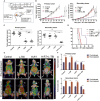

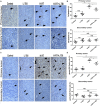
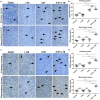
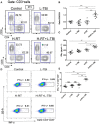
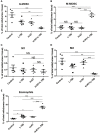
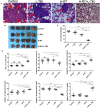

Similar articles
-
Fractionated but not single-dose radiotherapy induces an immune-mediated abscopal effect when combined with anti-CTLA-4 antibody.Clin Cancer Res. 2009 Sep 1;15(17):5379-88. doi: 10.1158/1078-0432.CCR-09-0265. Epub 2009 Aug 25. Clin Cancer Res. 2009. PMID: 19706802 Free PMC article.
-
Ablative Tumor Radiation Can Change the Tumor Immune Cell Microenvironment to Induce Durable Complete Remissions.Clin Cancer Res. 2015 Aug 15;21(16):3727-39. doi: 10.1158/1078-0432.CCR-14-2824. Epub 2015 Apr 13. Clin Cancer Res. 2015. PMID: 25869387 Free PMC article.
-
Effect of triple therapy with low-dose total body irradiation and hypo-fractionated radiation plus anti-programmed cell death protein 1 blockade on abscopal antitumor immune responses in breast cancer.Int Immunopharmacol. 2023 Apr;117:110026. doi: 10.1016/j.intimp.2023.110026. Epub 2023 Mar 17. Int Immunopharmacol. 2023. PMID: 36934673
-
Postablation Modulation after Single High-Dose Radiation Therapy Improves Tumor Control via Enhanced Immunomodulation.Clin Cancer Res. 2020 Feb 15;26(4):910-921. doi: 10.1158/1078-0432.CCR-18-3518. Epub 2019 Nov 22. Clin Cancer Res. 2020. PMID: 31757878
-
The tumor-immune microenvironment and response to radiation therapy.J Mammary Gland Biol Neoplasia. 2010 Dec;15(4):411-21. doi: 10.1007/s10911-010-9194-9. Epub 2010 Dec 16. J Mammary Gland Biol Neoplasia. 2010. PMID: 21161342 Free PMC article. Review.
Cited by
-
Radiation drives tertiary lymphoid structures to reshape TME for synergized antitumour immunity.Expert Rev Mol Med. 2024 Oct 23;26:e30. doi: 10.1017/erm.2024.27. Expert Rev Mol Med. 2024. PMID: 39438247 Free PMC article. Review.
-
Application of individualized multimodal radiotherapy combined with immunotherapy in metastatic tumors.Front Immunol. 2023 Jan 12;13:1106644. doi: 10.3389/fimmu.2022.1106644. eCollection 2022. Front Immunol. 2023. PMID: 36713375 Free PMC article. Review.
-
Combination of radiotherapy and ICIs in advanced hepatocellular carcinoma: A systematic review of current evidence and future prospects (Review).Oncol Lett. 2025 May 14;30(1):342. doi: 10.3892/ol.2025.15088. eCollection 2025 Jul. Oncol Lett. 2025. PMID: 40438865 Free PMC article. Review.
-
Radiotherapy in the Era of Immunotherapy With a Focus on Non-Small-Cell Lung Cancer: Time to Revisit Ancient Dogmas?Front Oncol. 2021 Apr 21;11:662236. doi: 10.3389/fonc.2021.662236. eCollection 2021. Front Oncol. 2021. PMID: 33968769 Free PMC article. Review.
-
Implications of the Organ-Specific Immune Environment for Immune Priming Effect of Radiotherapy in Metastatic Setting.Biomolecules. 2023 Apr 18;13(4):689. doi: 10.3390/biom13040689. Biomolecules. 2023. PMID: 37189436 Free PMC article. Review.
References
-
- Demaria S, Kawashima N, Yang AM, Devitt ML, Babb JS, Allison JP, et al. . Immune-mediated inhibition of metastases after treatment with local radiation and CTLA-4 blockade in a mouse model of breast cancer. Clin Cancer Res. (2005) 11:728–34. - PubMed
Publication types
MeSH terms
Substances
LinkOut - more resources
Full Text Sources
Other Literature Sources
Research Materials

